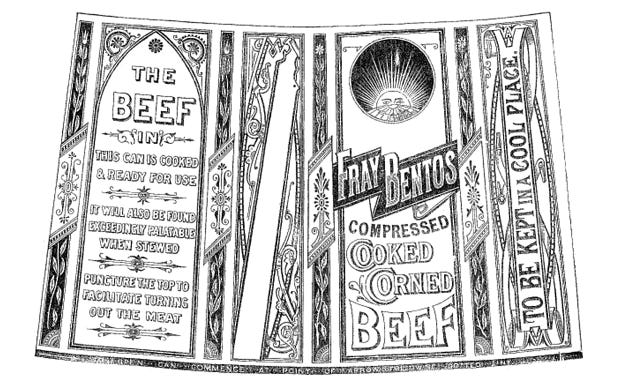18 November 2022. Modernity | Brands
The end of modernity and our crisis of meaning // The end of signs
Welcome to Just Two Things, which I try to publish three days a week. Some links may also appear on my blog from time to time. Links to the main articles are in cross-heads as well as the story. A reminder that if you don’t see Just Two Things in your inbox, it might have been routed to your spam filter. Comments are open.
Have a good weekend.
1: The end of modernity and our crisis of meaning
I went yesterday to hear Richard McNeill Douglas, who’s an academic at the CUSP research programme, talk about the idea that 1972 was “the high water mark of modernity”. The event was in the Inter-Planetary Space Society in London. This idea hangs on two significant events: the launch of the last Apollo flight, Apollo 17, in December of that year, and the publication earlier in the year of The Limits to Growth. Douglas told this story by hanging it on vignettes about four white Americans.
Three of these were associated with the Apollo programme: Eugene Cernan, the Commander of Apollo 17; his crew member Harrison Schmitt, a geologist who was the only scientist to walk on the Moon; and Edgar Mitchell, who landed on the moon as part of Apollos 14 and 16.
Cernan was the first and possibly the last person to drive on the Moon—Werner von Braun, immortalised by Tom Lehrer (“who cares where they come down”) had told him “you’re going to need mobility”. Schmitt was on the programme because Congress had asked NASA to do more science, and he took the famous “blue marble” photo. Mitchell, who said later that “something happens to you out there”, became obsessed with extra-sensory perception and the paranormal, notably researching Uri Geller.
(‘The Blue Marble’, seen from Apollo 17. Public domain.)
By the time of Apollo 17, the Mariner spacecraft had sent back enough information about the other planets to suggest, as the writer CP Snow put it, “the solar system is a desperately disappointing place”.
Douglas suggested that this disappointment extended into the realm of science fiction, where landing on the Moon had ended centuries of fantasies about it, going back to Francis Godwin’s fantasy story ‘The Man in the Moone’, written in 1638.
The fourth vignette was about Jay Forrester, the MIT academic whose systems dynamics modelling had provided the backbone to The Limits to Growth. I’ve written about Limits here before, but the story it told, in its ‘base case’—the then present trends extended—was that if growth continued in the same way the environmental basis for human society would be overwhelmed at some point in the 21st century.
Douglas’ version of this was that the Limits team saw their project as an optimistic one, not a pessimistic one. At the time they wrote it, we were still, as a species, living inside planetary limits, and other scenarios in the book and the model showed ways of continuing to live within limits.
Williams Behrens, one of the authors of Limits to Growth said that these projections were achievable: “All they needed was human action.” The book was a policy prescription project—the team thought it was “essential and obvious” that governments should and would attend to it.
Douglas’ conceit in this argument is that modernity is a form of religion, despite its secular nature. The transition from the middle ages to the modern age involved “the transfer of the idea of infinity from God to the material dimensions of time and space”, exemplified by the search for scientific and human knowledge. (I may not have caught all of this exactly right—Douglas was reading his text from a fairly dense paper rather than talking to us).
So what happened in 1972 was that the idea of growth, of expansion, reached its high water mark, and that caused a crack in the meaning system that had driven human societies, at least in the rich world, since the 17th century.
The sociologist Allan Schnaiberg characterised this moment as being the point at which science diverged. “Production science” represents “the power fantasy of modern science”, associated with “progress”. “Impact science” is about dealing with the effects of production science—in expressions such as climate science.
In other words, “science contradicts progress”, introducing “incoherence into the belief system of modernity.” It’s perhaps not complete coincidence that Harrison Schmitt became a campaigner against climate science, which he called “pure belief designed as science.”
Of course, a high water mark is the peak, not the end. When belief systems start to recede, other things fill the gap. This perspective opened up an interesting insight into neoliberalism, as a set of beliefs about material progress for its own sake, exemplified by the triumph of Hayek’s economics in public policy in the US and the United Kingdom in the 1980s and after. But it might also include the upsurge of irrationality that we have seen alongside those economic policies.
And one of the things that all of this helped me to understand was the extreme hostility of the reaction to Limits to Growth. I used to think it was because it attacked a deep worldview of our modern industrial culture. I realised that it went far deeper than that, to the deep core of our modern belief systems. The idea of “de-growth” is still struggling to make itself heard over the legacy of this.
There were three respondents to Douglas’ talk.
Will Davies of Goldsmiths noted that the world of architecture also marked the end of modernism in 1972, with the demolition of the Pruitt-Igoe complex in St Louis (here with a soundtrack by Philip Glass). He also suggested that modernism has had its critics since its earliest days—ever since Kant wrote ‘What is Enlightenment?’, in 1794. He also drew a thread from Hannah Arendt’s observation that Sputnik in particular, and more generally space expansionism in the ‘60s, marked our ‘alienation’ from earth, to Bruno Latour’s last book, Down to Earth, which argued that our human condition is to be bound to the rock we find ourselves on.
Rachel Hill of University College London suggested that the ‘blue marble’ represented a synthesis between the Apollo programme and Limits to Growth, in which the earth “emerges as an eco-object, sealed and fragile”. She drew out a reading of people such as Gerard K O’Neil, who still sees space “as the next habitats in human evolution”, and contrasted this with indigenous stories.
I hadn’t heard of Simon Ortiz’ story ‘Men on the Moon’ but it apparently offers an indigenous perspective on the Moon landings. When he hears of them, Faustin, the protagonist, “wondered if the men had run out of places to look for knowledge on earth.”
Floating through some of the discussion was a disagreement on how the Moon landings and the end of the space programme had influenced science fiction. Douglas thought it had disappeared into fantasy; Hill noted that 1974 marks the publication of Ursula LeGuin’s The Dispossessed, which includes a world where the inhabitants have few resources.
Douglas had finished his talk by saying that there was a path through the crisis of meaning—even a spiritual crisis—caused by the end of modernity. It involved
“The finitude of the finite…. The reality of the infinite that transcends it.”
The third respondent, Clare Foster-Gilbert, of the Westminster Abbey Institute, chose to address this aspect of the talk. She told the story of the re-wilding of Knepp, in West Sussex, which she had visited recenlty. Charlie Burrell tried to make the farm, as was, work as a farm, but none of it succeeded.
So “he became helpless”, she said. “When they gave nature time and space, life poured in and with that came hope. The infinite emerges from the feeling of helplessness, and you have to let go.”
Douglas noted in his closing remarks that we’ve known since 1972 that we are living on a finite planet, and yet our politicians have done nothing about. This, he said, is an obvious failure, since one of the first tasks of the polity (as Hobbes said) is to keep its people safe. He’s clearly puzzled by this failure.
His other point is that, in a non-religious age, we still need a theodicy. The theodicy of modernism emerged from the breakdown of the theodicy of the late middle ages, when people felt that God had become a“deus absconditas.”
Our conditions today are quite similar. Modern metaphysics, based on the idea of the infinite, including infinite growth, has also broken down. Perhaps we need to look for the infinite in different places.
2: The death of the sign
At risk of seeming quirky, this post is based on a couple of things I noticed on recent travels. The first is a notice at the bottom of a restaurant bill in Cheltenham. I took a photo because it was the first time I’d seen something as explicit as this:
(Photo: Andrew Curry, CC BY SA-NC 4.0)
It was an independent restaurant. This probably doesn’t need spelling out, but if you pay a service charge on a card in a restaurant in the UK, you can’t be sure that the staff will get it. There’s even a Private Member’s Bill in the British House of Commons on this.
The second one was on a milk carton in the kitchen of a hotel in Paris. Roughly translated, this reads:
“This milk pays a fair price to its producer.”
(Photo: Andrew Curry, CC BY SA-NC 4.0)
Underneath, there’s a second statement, which says (approximately) that because of the urgency of the situation facing producers and dairies, it has increased the subsidy it pays to maintain a fair price.
The reason these photos were of interest to me is that these statements are doing the lifting that brands used to do.
Brands developed in the late 19th century as mass markets started to develop in the richer world. The idea was that the name of the company represented a shorthand that provided an assurance of quality—initially, actually, more often an assurance of safety—to its buyers.
The first brands were mostly in the area of food or what we’d now call “personal care”, but 19th century customers knew as “soap”. Fray Bentos, for example, an Anglo-Argentine company then known for its tinned corned beef, was basically a promise that its tinned meat was safe to eat.
(Fray Bentos’ original trademark. Public Domain)
Obviously things moved on in the 20th century. Brands and branding became the stuff of marketing degrees and cultural studies analysis.
Any technology, say the McLuhans in their Laws of Media, will first enhance some aspect of human life, but then eventually reverses into its opposite. The car first creates speed and then reverses into congestion. So brands first enhanced consumer clarity and then reversed into obfuscation and manipulation—or even some form of market-based Orwellian newspeak.
I’m not going to labour the point. But what struck me about both these images is that the only way to get 21st customers to believe something is to, literally, spell it out.
Brands have spent five or six decades perfecting signs and signifiers, and when Judith Williamson wrote her book on decoding advertising in the ‘70s it was path breaking. But now customers can read all of that just as well as the marketing people can. And they don’t much like what they see.
j2t#394
If you are enjoying Just Two Things, please do send it on to a friend or colleague.







